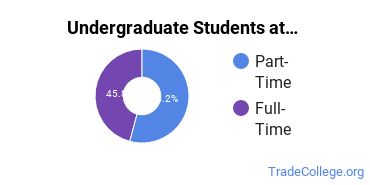Wallace State Community College, Hanceville Trade Programs
Wallace State Community College, Hanceville is a public institution situated in Hanceville, Alabama. Wallace State, Hanceville is located in the countryside, which is perfect for students who enjoy a rural lifestyle.
Featured schools near , edit
Where Is Wallace State Community College, Hanceville?

Contact details for Wallace State, Hanceville are given below.
| Contact Details | |
|---|---|
| Address: | 801 Main St Nw, Hanceville, AL 35077-2000 |
| Phone: | 256-352-8000 |
| Website: | www.wallacestate.edu |
Can I Afford Wallace State, Hanceville?
| In State | Out of State | |
|---|---|---|
| Tuition | $3,810 | $7,620 |
| Fees | $1,170 | $1,170 |
| Books and Supplies | $2,000 | $2,000 |
| On Campus Room and Board | $4,900 | $4,900 |
| On Campus Other Expenses | $8,720 | $8,720 |
Student Loan Debt
While almost two-thirds of students nationwide take out loans to pay for college, the percentage may be quite different for the school you plan on attending. At Wallace State, Hanceville, approximately 22% of students took out student loans averaging $5,416 a year. That adds up to $21,664 over four years for those students.
Wallace State Community College, Hanceville Undergraduate Student Diversity

Gender Diversity
Of the 2,349 full-time undergraduates at Wallace State, Hanceville, 36% are male and 64% are female.

Racial-Ethnic Diversity
The racial-ethnic breakdown of Wallace State Community College, Hanceville students is as follows.

| Race/Ethnicity | Number of Grads |
|---|---|
| Asian | 32 |
| Black or African American | 127 |
| Hispanic or Latino | 169 |
| White | 1,905 |
| International Students | 11 |
| Other Races/Ethnicities | 105 |
Over 3 countries are represented at Wallace State, Hanceville. The most popular countries sending students to the school are Nepal, India, and Bangladesh.
Wallace State Community College, Hanceville Trade School Concentrations
The table below shows the number of awards for each concentration.
References
*The racial-ethnic minorities count is calculated by taking the total number of students and subtracting white students, international students, and students whose race/ethnicity was unknown. This number is then divided by the total number of students at the school to obtain the racial-ethnic minorities percentage.
More about our data sources and methodologies.
Featured Schools
 Request Info
Request Info
|
Southern New Hampshire University You have goals. Southern New Hampshire University can help you get there. Whether you need a bachelor's degree to get into a career or want a master's degree to move up in your current career, SNHU has an online program for you. Find your degree from over 200 online programs. Learn More > |
